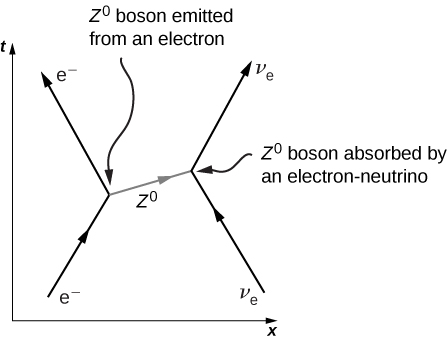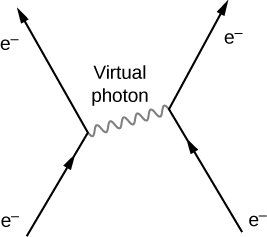| << Chapter < Page | Chapter >> Page > |

According to QED, the electromagnetic force is transmitted between charged particles through the exchange of photons. The theory is based on three basic processes: An electron travels from one place to the next, emits or absorbs a photon, and travels from one place to another again. When two electrons interact, one electron emits the photon and the other receives it ( [link] ). Photons transfer energy and momentum from one electron to the other. The net result in this case is a repulsive force. The photons exchanged are virtual. A virtual particle is a particle that exists for too short a time to be observable. Virtual photons may violate the law of conservation of energy. To see this, consider that if the photon transit time is extremely small, then Heisenberg’s uncertainty principle states that the uncertainly in the photon’s energy, may be very large.

To estimate the range of the electromagnetic interaction, assume that the uncertainty on the energy is comparable to the energy of the photon itself, written
The Heisenberg uncertainly principle states that
Combining these equations, we have
The energy of a photon is given by , so
The distance d that the photon can move in this time is therefore
The energy of the virtual photon can be arbitrarily small, so its wavelength can be arbitrarily large—in principle, even infinitely large. The electromagnetic force is therefore a long-range force.
The weak nuclear force is responsible for radioactive decay. The range of the weak nuclear force is very short (only about m) and like the other forces in the Standard Model, the weak force can be described in terms of particle exchange. (There is no simple function like the Coulomb force to describe these interactions.) The particle exchanged is one of three bosons: and . The Standard Model predicts the existence of these spin-1 particles and also predicts their specific masses. In combination with previous experiments, the mass of the charged W bosons was predicted to be and that of the was predicted to be . A CERN experiment discovered particles in the 1980s with precisely these masses—an impressive victory for the model.
The weak nuclear force is most frequently associated with scattering and decays of unstable particles to light particles. For example, neutrons decay to protons through the weak nuclear force. This reaction is written
where n is the neutron, p is a proton, is an electron, and is a nearly massless electron neutrino. This process, called beta decay, is important in many physical processes. A Feynman diagram of beta decay is given in [link] (a). The neutron emits a and becomes a proton, then the produces an electron and an antineutrino. This process is similar to the scattering event

Notification Switch
Would you like to follow the 'University physics volume 3' conversation and receive update notifications?